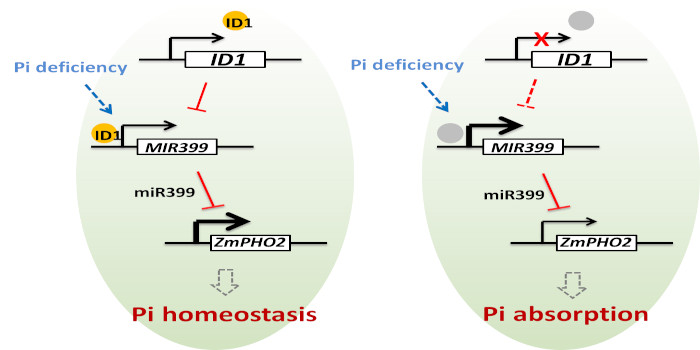Phosphate uptake in maize
Wang, Yuan, et al. explore the regulatory connection between phosphorus nutrient homeostasis and vegetative-reproductive development in maize.
Background: Phosphorus is an essential macronutrient for plant growth and development. To cope with phosphorus limitation, plants have evolved sophisticated strategies to coordinate phosphorus acquisition, scavenging and recycling. Maize is an important crop and cultivated widely for both staple food and industrial usage. Although phosphorus is a major constituent of the fertilizers required to sustain high yields in maize, global phosphorus resources are quickly diminishing and may be exhausted in the near future.
Question: We sought to understand the underlying molecular mechanisms behind phosphate acquisition and utilization in maize to develop varieties with high phosphorus use efficiency.
Findings: We observed that overexpressing microRNA399 (miR399) or knocking out of its target gene ZmPHO2 results in an apparent leaf senescence phenotype after pollination. We further discovered that the transcription factor INDETERMINATE1 (ID1) functions as an autonomous upstream regulator of phosphorus homeostasis by suppressing the transcription of ZmMIR399 genes, thus decreasing the accumulation of mature miR399 and alleviating the cleavage of ZmPHO2 transcripts, ultimately contributing to the maintenance of phosphorus homeostasis in maize. Our work establishes a regulatory connection between phosphorus nutrient homeostasis and vegetative-reproductive development in maize. More importantly, we show that ZmPHO2 underwent strong selection during maize domestication and cultivation. This study provides genetic resources for improving maize phosphorus use efficiency and breeding low phosphorus-tolerant maize varieties by editing the ID1-miR399-ZmPHO2 module.

Next steps: We will attempt to generate ID1-modified plants to fine-tune flowering time and phosphorus uptake in maize. The specific functions of each MIR399 family member may also be interrogated by generating genome-edited mutants. As we discovered that Bx genes involved in benzoxazinoid biosynthesis are also affected by miR399, we hope to further explore the mechanism of miR399 functioning as a negative regulator of plant immunity.
Reference:
Xufeng Wang, Dan Yuan, Yanchun Liu, Yameng Liang, Juan He, Xiaoyu Yang, Runlai Hang, Hong Jia, Beixin Mo, Feng Tian, Xuemei Chen, and Lin Liu (2023). INDETERMINATE1 autonomously regulates phosphate homeostasis upstream of the miR399-ZmPHO2 signaling module in maize. Plant Cell. https://doi.org/10.1093/plcell/koad089
Chinese Translation
背景回顾:磷是植物生长发育不可缺少的元素之一。为了应对磷缺乏,植物已经进化出多种复杂的策略来协调磷酸盐的获取、清除和再利用(回收)过程。玉米是一种重要的粮食作物,如今已经在全世界范围内被广泛种植。磷是维持玉米高产所需肥料的主要成分之一,然而磷资源正在迅速减少,并可能在不久的将来枯竭。
科学问题:我们试图了解玉米磷酸盐获取和利用的潜在分子机制,以开发具有高磷酸盐利用效率的品种。
研究发现:通过实验室和大田评估,过表达玉米microRNA399家族或敲除其靶基因 ZmPHO2 会导致玉米在授粉后出现明显的叶片早衰表型。进一步研究发现,转录因子 INDETERMINATE1 (ID1) 作为上游调节因子可以有效抑制 ZmMIR399 基因的转录,从而减少成熟 miR399 的积累并减轻其对靶标基因ZmPHO2的转录切割,最终将有助于玉米体内磷稳态的维持。我们的工作试图在玉米的磷稳态和营养、生殖发育之间建立联系。更重要的是,我们发现 ZmPHO2 在玉米驯化和栽培过程中可能受到了强烈的选择。本研究在玉米中建立了ID1-miR399-ZmPHO2调控模块,为提高玉米磷酸盐利用效率和培育耐低磷玉米品种提供了宝贵的遗传资源。
展望未来:后期,我们将尝试创建不同ID1表达水平的转基因或基因编辑植物来微调玉米的开花时间和磷酸盐吸收效率。每个 miR399 家族成员的具体功能尚不清晰,我们将试图利用 CRISPR-Cas9 技术生成每个 miR399 家族成员对应的突变体来研究其功能。我们发现参与苯并恶嗪(丁布)次生代谢途径生物合成的Bx基因表达也受到miR399表达的影响,希望进一步探索miR399在植物免疫中作为负调节因子发挥作用的机制。



